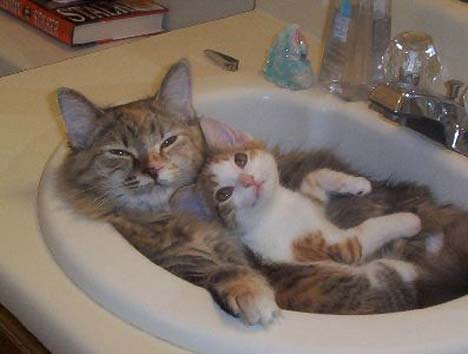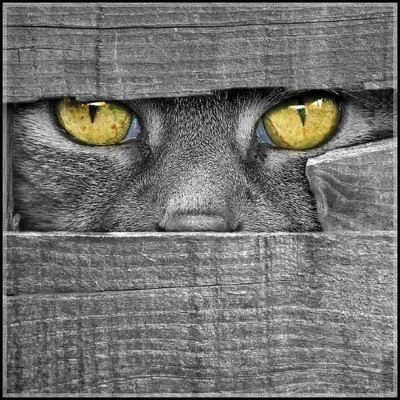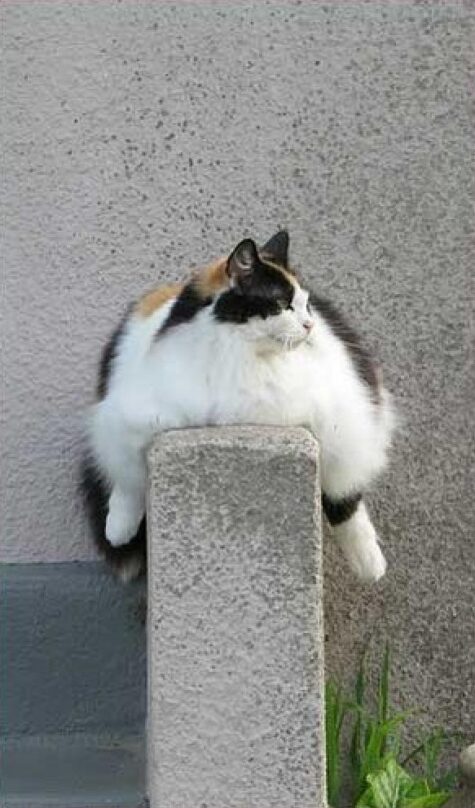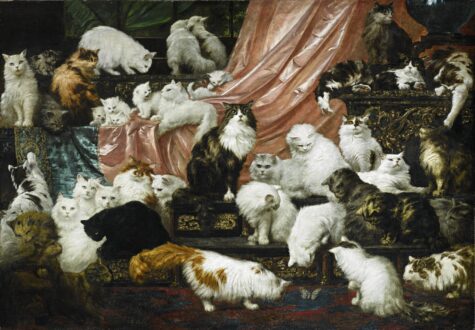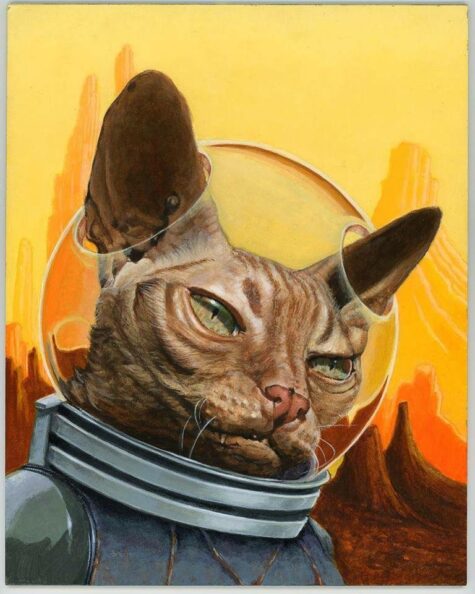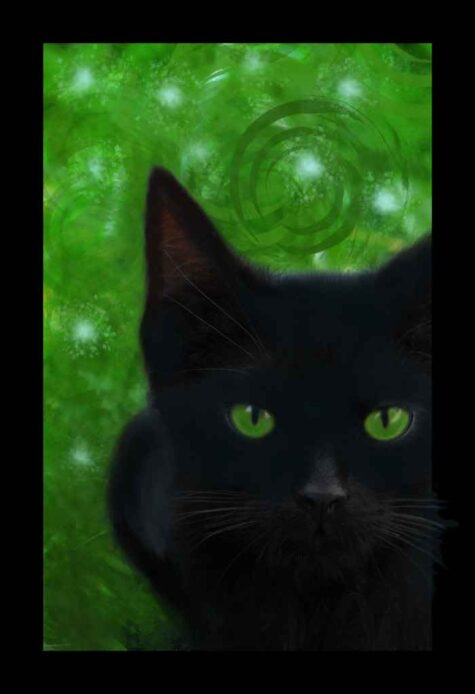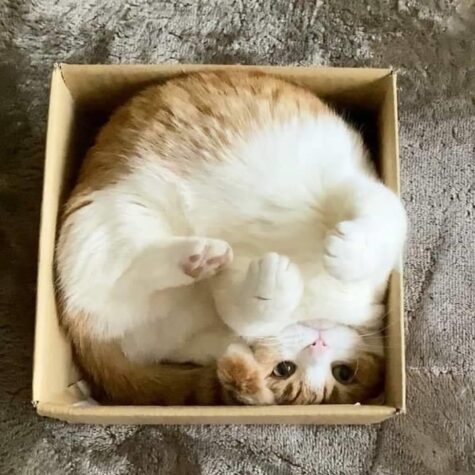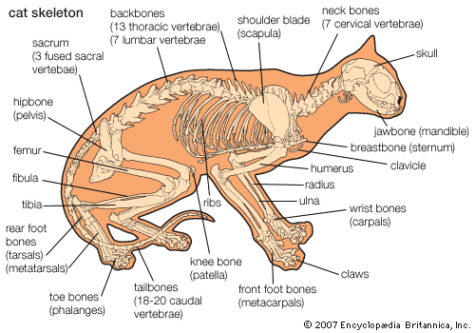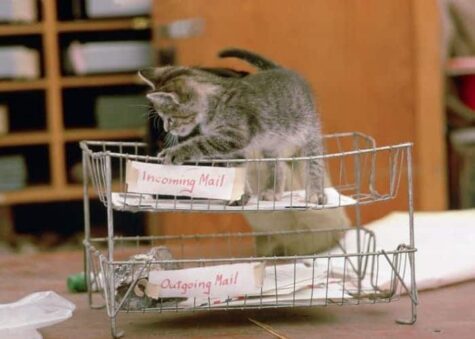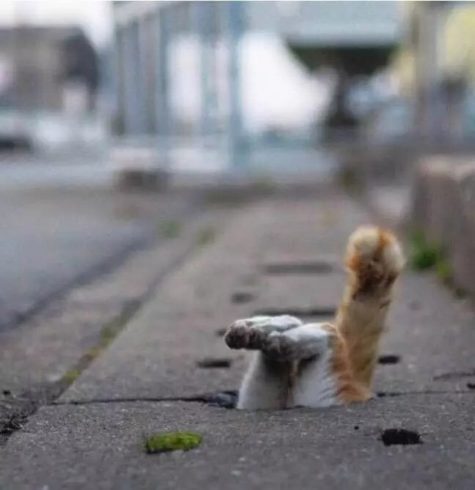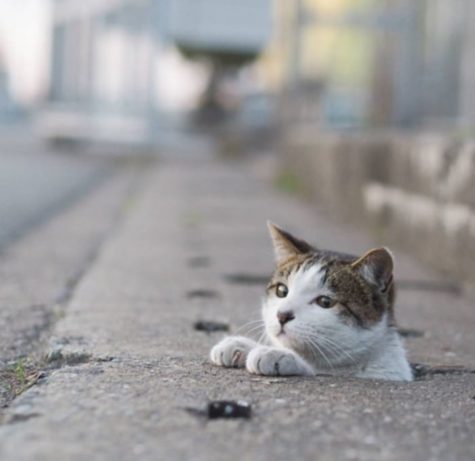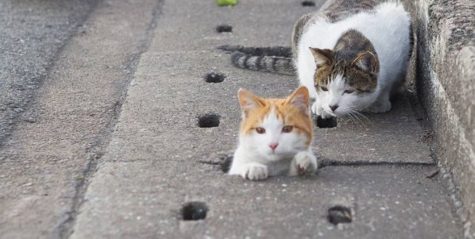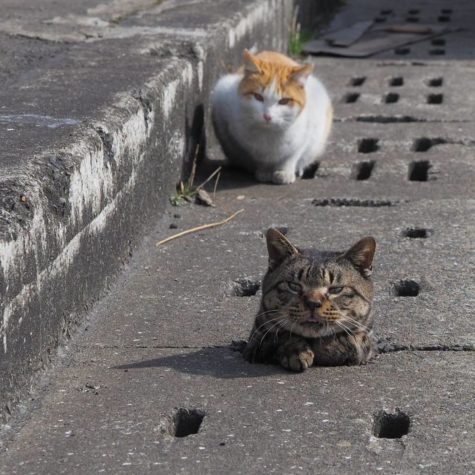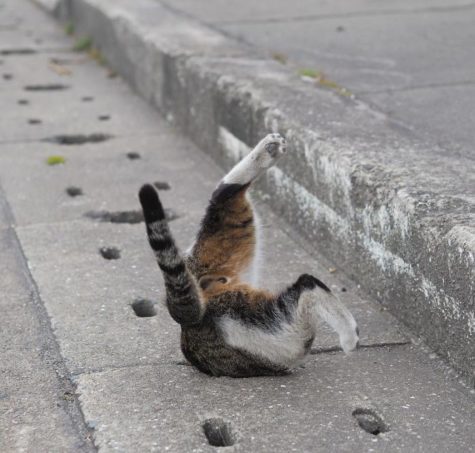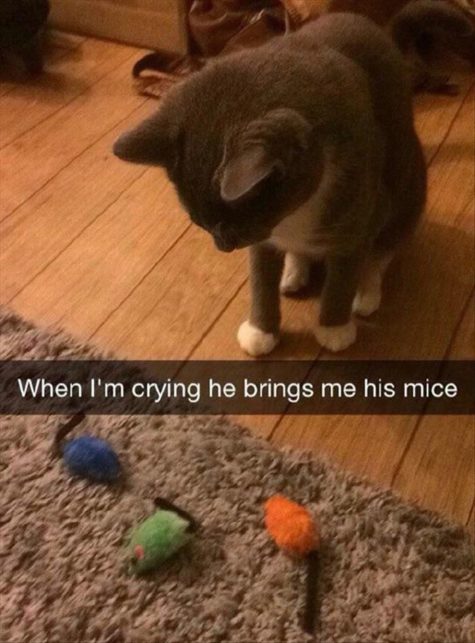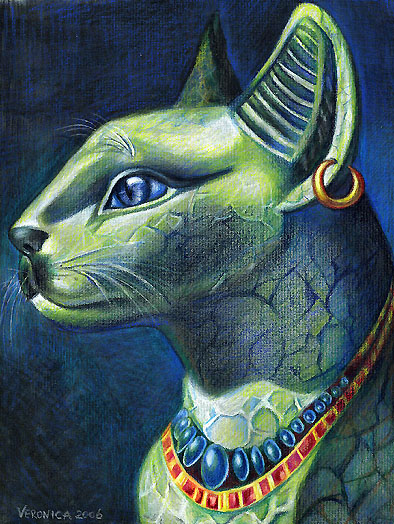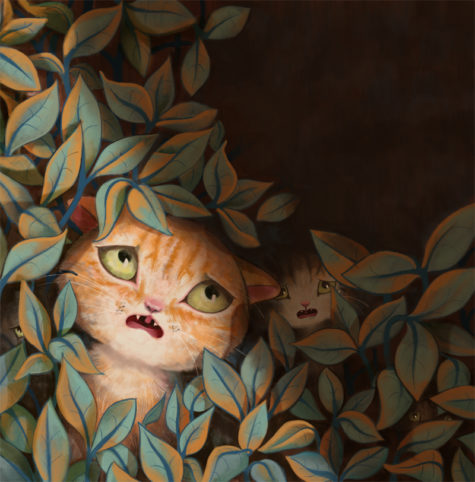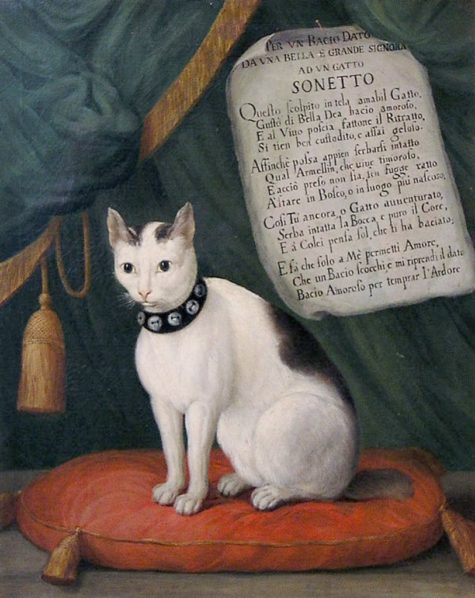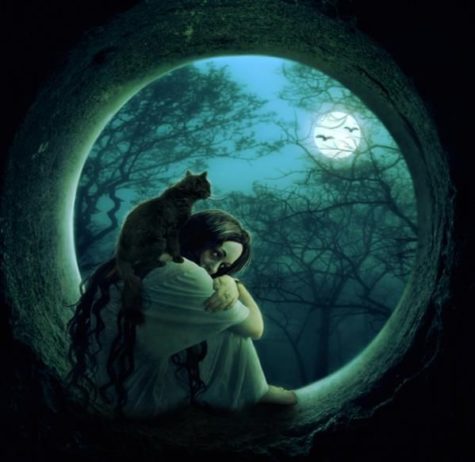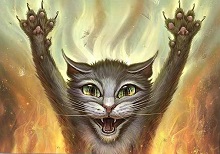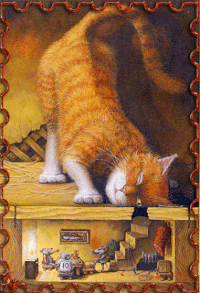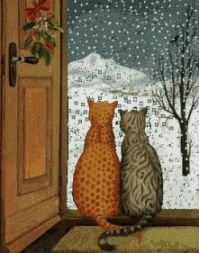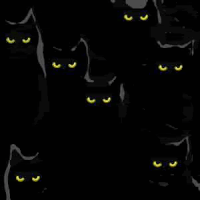Feline Facts
Fifty Fun Facts About Cats
Happy Respect Your Cat Day! (Not that they’d have it any other way.) If you want to celebrate Felis silvestris in all its furry glory, try sharing some of these 50 bits of cat trivia.
1:
Cats spend around 30 to 50 percent of their day grooming themselves. This behavior serves several purposes: It helps cats tone down their scent so they can avoid predators, it cools them down, it promotes blood flow, and it distributes natural oils evenly around their coat, allowing them to stay warm and dry. Grooming also serves as a sign of affection between two cats, and it’s thought that saliva contains enzymes that serve as a natural antibiotic for wounds.
2:
Just because a cat is purring doesn’t mean the cat is happy. Cats often make the sound when they’re content, but they also purr when they’re sick, stressed, hurt, or giving birth.
3:
Scientists don’t quite know why cats purr, but one hypothesis is that the sound frequency of purring—between 25 and 150 Hertz—”can improve bone density and promote healing,” theorizes Leslie A. Lyons, an assistant professor at the School of Veterinary Medicine at the University of California, Davis, in an article for Scientific American. “Because cats have adapted to conserve energy via long periods of rest and sleep, it is possible that purring is a low energy mechanism that stimulates muscles and bones without a lot of energy.”
4:
Ever wonder why catnip lulls felines into a trance? The herb contains several chemical compounds, including one called nepetalactone, which a cat detects with receptors in its nose and mouth. The compounds trigger the typical odd behaviors you associate with the wacky kitty weed, including sniffing, head shaking, head rubbing, and rolling around on the ground.
5:
More than half of the world’s felines don’t respond to catnip. Scientists still don’t know quite why some kitties go crazy for the aromatic herb and others don’t, but they have figured out that catnip sensitivity is hereditary. If a kitten has one catnip-sensitive parent, there’s a one-in-two chance that it will also grow up to crave the plant. And if both parents react to ‘nip, the odds increase to at least three in four.
6:
Can’t afford a private eye? A feline might be able do the job for free. In the 1960s, ambassador Henry Helb—who then lived in the Dutch Embassy in Moscow—noticed that his two Siamese kitties were arching their backs and clawing at one of the walls. Helb had a hunch that the cats heard something he couldn’t, and sure enough, he found 30 tiny microphones hidden behind the boards.Instead of busting the spies, Helb and his staff took advantage of the surveillance and griped about household repairs or packages stuck in customs while standing in front of the mics. The eavesdroppers took care of their complaints—and apart from Helb and his companions, no one was the wiser.
7:
Chances are, your cat hates your music—but they might like tunes written by composer David Teie, who partnered with animal scientists to make an album called Music for Cats. Released in 2015, the songs are “based on feline vocal communication and environmental sounds that pique the interest of cats,” Teie’s website states.
8:
If you adore felines, you’re in good company: Many of history’s most famous figures—including Florence Nightingale, Pope Paul II, Mark Twain, and the Brontë sisters—all owned, and loved, cats.
9:
Still, the title of history’s craziest cat man might go to Abraham Lincoln. Mary Todd Lincoln was once asked if her husband had any hobbies. Her response? “Cats!”
10:
A kindle isn’t just an e-reader—it’s also a word that’s used to describe a group of kittens born to one mama cat. Meanwhile, a group of full-grown cats is called a clowder.
11:
The Guinness World Records doesn’t award the world’s fattest pets since officials don’t want to encourage people to overfeed their pets. But in 2003, a Siamese cat named Katy was a serious contender for the record. Katy, who lived in Asbest, Russia, was given hormones to stop her mating. The treatment had an unintended side effect: It dramatically increased her appetite, and the hungry kitty ballooned to 50 pounds.
12:
A rich British antique dealer named Ben Rea loved his cat Blackie so much that when he died in 1988, he left most of his estate—totaling nearly $13 million—to the lucky (albeit likely indifferent) feline. The money was split among three cat charities, which had been instructed to keep an eye on Rea’s beloved companion. To this day, Blackie holds the Guinness World Record for Wealthiest Cat.
13:
As for the world’s oldest living cat, the title belongs to a sometimes-cranky white-and-orange kitty named Rubble, who celebrated his 30th birthday in June, 2018.
14:
Ever wondered why your cat likes to rhythmically massage you with its paws? Experts haven’t figured out why cats like to knead, but they’ve come up with several possible explanations, one being that your kitty is trying to mark their “territory” (that’s you!) with the scent glands in their paws. And since kittens knead their mama’s belly to stimulate milk production, there’s also a chance that they carry this behavior into adulthood—a phenomenon known as a “neotenic behavior.”
15:
Looking to elevate your vocabulary? Try using the word ailurophile in a casual conversation. It’s a fancy word for “cat lover,” and it’s derived from the Greek word for cat, ailouros, and the suffix -phile, meaning “lover.” Conversely, the word ailurophobe—a combination of ailouros plus phobe—describes someone who hates cats.
16:
In 2015, a 6-by-8.5-foot oil painting billed as the “world’s largest cat painting” sold at auction for more than $820,000. It’s called My Wife’s Lovers, and it once belonged to a wealthy philanthropist named Kate Birdsall Johnson. She loved felines so much that she owned dozens (some even say hundreds) of kitties, and commissioned a painter to capture her Turkish Angoras and Persians in their natural element. Since Johnson’s husband called the clowder “my wife’s lovers,” the nickname was selected as the artwork’s title.
17:
Contrary to popular belief, cats don’t always land on their feet when they fall. But more often than not, all four paws end up touching the ground. Cats have a fantastic sense of balance, so they’re able to tell “up” from down and adjust their bodies accordingly. If they sense they’re plummeting downwards, they twist their flexible backbones mid-air, allowing them to right themselves so they don’t fall splat on their backs. Additionally, cats can spread their legs out to “parachute” through the air, plus they’re also small, light-boned, and covered in thick fur—meaning their fall isn’t going to be as hard as, say, a dog’s.
18:
In 2018, America’s most popular cat breed was the Exotic—a flat-faced kitty that’s essentially a short-haired version of a Persian cat. The second most beloved breed was the Ragdoll, and the British Shorthair ranked at No. 3.
19:
The musical Cats is based on a collection of T.S. Eliot poems called Old Possum’s Book of Practical Cats. Published in 1939, it follows the whimsical antics of a group of felines—but the manuscript was originally intended to feature dogs, too. In the end, though, Eliot determined that “dogs don’t seem to lend themselves to verse quite so well, collectively, as cats.”
20:
On October 18, 1963, French scientists used a rocket to launch the first cat into space. The feline’s name was Félicette, and she made it safely to the ground following a parachute descent.
21:
A train station in Southeastern Japan is presided over by an adorable “stationmaster”: a 6-year-old calico cat named Nitama. The Kishi train station near Wakayama City hired Nitama in 2015, just a few months after its prior feline mascot, Tama, died from acute heart failure at the age of 16.
22:
Even if you’re not allergic to cats, your cat might be allergic to you. One in 200 cats are believed to have asthma—and this number continues to rise among indoor kitties as they’re more frequently exposed to cigarette smoke, dust, human dandruff, and pollen.
23:
Greyhound dogs are the ones with a bus line named after them, but cats are pretty speedy, too: The average running feline can clock around 30 mph.
24:
Nobody quite knows why black cats are considered to be bad luck, but this myth has persisted across Western civilization for centuries. Felines with dark fur first became linked with the Devil during the Middle Ages, and when the Black Death pandemic ravaged Europe in the mid-14th century, superstitious individuals responded by killing off the black cat population. Little did they know that vermin carried the deadly disease and that the rodent-eating cats actually helped curb its spread. And black cats eventually became associated with witches because women accused of practicing black magic tended to adopt alley cats as companions.
25:
Black cats are considered to be a bad omen in the U.S., but in Great Britain and Japan, they’re perceived as auspicious. In the English Midlands, new brides are given black cats to bless their marriage, and the Japanese believe that black cats are good luck—particularly for single women. Meanwhile, the Germans believe that a black cat crossing your path from left to right is ominous, but if the feline switches directions and goes right to left, it’s fortuitous.
26:
The ancient Egyptians revered cats, and even worshiped a half-feline goddess named Bastet. People who harmed or killed cats faced harsh legal sentences, including the death penalty.
27:
The world’s first major cat show was held at London’s Crystal Palace in July 1871. Hundreds of felines (and dozens of breeds) were placed on display, and around 200,000 guests are said to have attended the event.
28:
Remember Nyan Cat? The famous viral meme of a gray kitty with a Pop-Tart body who shoots rainbows from its posterior (the internet, folks!) was based on a real-life feline: a Russian Blue named Marty, owned by Nyan cat illustrator Chris Torres.
29:
Most cats weigh in the single or low-double digits, but some breeds are truly huge. For instance, Norwegian Forest Cats, Maine Coons, and Ragdolls often range in weight from 15 to 22 pounds.
30:
Long before Keyboard Cat took the internet by storm, inventor Thomas Edison filmed two kitties “boxing” inside a ring. Created in 1894, the brief clip proves that humans have been obsessed with cute cat videos since long before the advent of YouTube.
31:
Remember Socks the Cat, the black-and-white tuxedo cat owned by Bill Clinton’s family during his time in the Oval Office? During the early 1990’s, Super Nintendo Entertainment System created a video game called Socks the Cat, featuring the First Feline. It was never officially released, and when the game’s publisher shut down, Socks the Cat was lost for years, until video game collector Tom Curtin bought the (reportedly) only existing copy, purchased the rights, and partnered with game publisher Second Dimension to give it a second life. Socks the Cat was slated for an official release in 2017.
32:
Some Maine Coon cats are born with six toes.
33:
Sphinx cats don’t have fur coats, but their body temperature is still four degrees warmer than a typical feline.
34:
Male cats have barbed penises. While painful for the lady cat, they do serve a purpose: The barbs stimulate the vulva, allowing the female to ovulate, and they also keep her from escaping mid-coitus. (Felines are typically loners, and not that into sex.)
35:
If you went to college, you’re more likely to have a cat than a dog. In 2010, researchers from the University of Bristol surveyed 3000 people about their pets, geography, and scholastic history. They found that people with university degrees were 1.36 times more likely to own a kitty than other pet owners. This phenomenon might be attributed to the fact that cats are low-maintenance, and therefore better companions for accomplished people with busy careers.
36:
Why do cats love to cuddle up in boxes? Animal experts think that the enclosed spaces make felines feel more protected, secure, and important—kind of like they’re back in the womb. (Sure enough, researchers found that when shelter cats are provided with boxes to cuddle up in, they adjust faster and are less stressed than kitties that aren’t given boxes.) Also, sleeping in a box might help a feline retain more body heat so it stays nice and toasty, and therefore relaxed.
37:
Experts think that cats hate water because it’s uncomfortable to have soggy fur, or because it’s frightening for a kitty to lose control of its buoyancy.
38:
While many kitties hate water, not all do. Breeds including the Turkish Van, Maine Coons, and Bengals are said to enjoy taking a dip every now and then.
39:
Cats are genetically predisposed to not be able to taste sweets. They will likely nibble off your plate if it contains meat, but they’ll leave it alone if it’s laden with cake.
40:
A cat has 244 bones in its entire body—even more than a human, who only has 206 bones.
41:
Nobody knows quite why cats meow, but experts think they might be channeling their inner kitten. Baby cats make the plaintive noises to get their mother’s attention, but as full-grown felines, they don’t meow while interacting with other cats. Some experts think that felines use the noises they made as infants with humans to convey their emotions and physical needs.
42:
Cats sweat through their paws (and sometimes when they get very hot they pant).
43:
According to one estimate, a cat spends nearly two-thirds of its life asleep.
44:
The iconic Algonquin Hotel in midtown Manhattan owns a pampered lobby cat named Hamlet. He’s one of a dozen rescue felines that have lived in the storied institution since the early 1920s. Hamlet took over the post following three Matildas. (Matilda III passed away in October 2017.)
45:
In the 1870s, the city of Liège, Belgium tried to train 37 cats to deliver the mail. Letters were enclosed in waterproof bags tied around the kitties’ necks, but it turns out that cats weren’t great at delivering the goods on time (or to the correct address).
46:
Approximately 200 feral cats roam the grounds of Disneyland, where they help control the amusement park’s rodent population. They’re all spayed or neutered, and park staffers provide them with medical care and extra food.
47:
The Hungarian word for “quotation marks,” macskaköröm, literally translates to “cat claws.”
48:
Napoleon, Caesar, Genghis Khan, and Hitler are all said to have hated cats.
49:
There are an estimated 85.8 million pet cats in the U.S. In contrast, there are only an estimated 78 million dogs.
50:
A cat can jump up to five times its height, or six times its length—and make the entire thing look easy.
Source: Mental Floss
Drain Pipe Kitties
Kitty Comfort
The History Of The Domestic Cat
Our English word “cat” doesn’t seem to have come into general usage until around 300 A.D., give or take a few decades or so. It is interesting to note that several of the world’s languages call this animal by a name very similar to the English words “cat” or “puss” (which itself is believed to have derived from the name of the ancient Egyptian goddess Pasht, a cat-headed deity who was considered a darker manifestation of Bast; a.k.a.Bastet, acknowledged as the Mother of ALL cats and a goddess).
For instance, all the following examples are the words for the creature we call “cat”:
- French ~ Chat
- Welsh ~ Cath
- Arabic ~ Kitt
- Polish ~ Kot
- Syrian ~ Kato
- Sanskrit ~ Puccha
- Persia ~ Pushak
- Italian ~ Gatto
- Spanish ~ Gato
- Lithuanian ~ Puize
- German ~ Katze
- Russian ~ Kots
- Irish ~ Pus
As for the Egyptians, they called the creature Mau, meaning “to see.” No doubt the name also made onomatopoetic reference to the cat’s familiar meowing. No one really knows for certain, but it is believed that the cat may have been domesticated by these ancient Egyptians 4,000 to 5,000 years ago; relatively recent when you consider that the dog has been a companion to humans for 20,000 years, perhaps even longer. Some experts theorize that this human/dog relationship may have been going on as long as 50,000 years. As a result, the cat has retained many of its natural instincts and behaviors, having only been among humans a short while, whereas dogs have evolved right alongside us for quite some time now.
There is something about their confident personality that we admire. In fact, the ancient Egyptians were so fascinated by this detached quality of the cat that they considered them to be nothing less than godlike. To the Egyptians all cats were divine, and extreme behavior was often acted out to reinforce this conviction. For instance, if a someone happened to come across a dead cat in the street, he or she would put on a loud display of sorrow and mourning just to make sure no one thought that they were responsible for killing the cat. You see, according to Egyptian law, being found guilty of cat murder was punishable by death.
Whenever a household cat died of natural causes, the entire family would go through a period of grief, shaving their eyebrows as a mark of their sadness. Deceased cats were very often mummified and entombed with fine jewelry and treasures; a custom usually reserved for only the most powerful and wealthy of the ruling class.
But by far, the most fanatical demonstration of Egypt’s devotion to her cats occurred in 500 B.C.2 during a period of warfare with Persia. At the city of Pelusium, the Persian and Egyptian armies engaged in fierce combat, but the Egyptians resisted the onslaught with a fixed determination to save their city. The resolve of the Egyptian war machine proved too much for the rapidly tiring Persian army. Sensing ruinous defeat if the battle continued, the Persians retreated while they still could. The Egyptians knew that this wouldn’t be the end of it, so the army maintained a condition of battle readiness, waiting for the Persians to return.
What the Persians were up to was a brilliant scheme that displayed a profound understanding of their enemy’s culture and beliefs. They discovered a kink in the Egyptian armor, a weakness they would fully exploit. Night after night, the Persians deployed their elite forces to the villages and towns of the surrounding countryside, silently capturing as many cats as they could lay their hands upon. Once satisfied with the number of animals they’d collected, the Persian army returned to the city of Pelusium.
The Egyptians first noticed the distant clouds of dust, kicked up by the approaching Persian army, at dawn. The troops were readied for battle in an orderly manner, well rested and ready for combat.
Within an hour, the two armies positioned themselves in assembled ranks, glaring at each other across the battlefield. The Egyptian General signaled for the attack. In an instant, the Egyptian army charged upon the Persians who, oddly enough, held their ground. The Egyptians roared like thunder as they rapidly advanced on the Persian front line. Suddenly, there was movement within the Persian forces. Curious, but undaunted, the Egyptians continued their charge.
Then, they saw a sight that nearly froze them in their tracks. Hundreds of panic stricken cats were released upon the battlefield. The Egyptian army watched in horror as the sacred animals ran about in deadly fear.
Confusion spread through the Egyptian ranks as the Persian army seized the opportunity to take the aggressive. Advancing upon the stunned Egyptians in a evenly paced march, each of the Persian soldiers held forth a terrified cat. The Egyptians knew then and there that they were defeated.
Not a single Egyptian soldier dared to engage the enemy, fearing that to do so might endanger the lives of the cats. Without suffering a single casualty, the Persians secured their victory, devastating the Egyptians.
It has been suggested that the Egyptians initially used the cat to control the rodent population which continually destroyed crops. This seems to be a reasonable speculation, but it’s obvious that the cat meant much more to the Egyptians than that. Kingdoms don’t loose wars merely for the sake of four-legged mousetraps.
Certainly, something of the cat’s behavior suggested that a very powerful spiritual connection existed between humans, cats, and the gods. The Pharaohs and the priests alike were quite protective of their honored feline population. The distribution of cats throughout the Kingdom was carefully regulated, while exportation of cats was absolutely forbidden. Since the cat insured agricultural security by keeping away harmful pests, a surplus of goods was able to develop which gave Egypt wealth and strength, and plenty of economic clout when it came to dealing with other countries. No wonder they guarded these animals so closely. The domesticated cat was nothing less than a priceless secret weapon that contributed immeasurably to the greatness of ancient Egypt.
But eventually domesticated cats did find their way out of Egypt thanks to the Greeks who stole the animals to control their own rodent problem, and to use as powerful bargaining chips in international trade. This didn’t go over so well with the Egyptians. In fact, one Pharaoh sent out his army to various lands in a futile effort to recapture the liberated felines and return them home to Egypt.
Unfortunately for the Egyptians, it was too late. Warfare and trade had resulted in the distribution of domesticated cats throughout the Mediterranean and perhaps by this time, even as far as Asia. The Egyptian monopoly on domestic cats had at last come to an end.
Phoenician cargo ships are thought to have brought the first domesticated cats to the European continent around 900 B.C. In time, the Romans adopted the cat as a symbol of freedom and liberty. Never quite venerating felines to the extent of the Egyptians, the Romans nevertheless held the cat in high regard, and it is believed that they are responsible for introducing the cat to Britain during the course of their numerous campaigns of conquest in that region.
Over the subsequent centuries, the domesticated cat proliferated throughout Europe, the Middle East, and China. Though no longer worshiped as deities, cats were still honored and appreciated for their mousing abilities no matter where they turned up. By the 11th Century, about the time the Crusades began, cats were in huge demand since the rats were beginning to overrun the cities. Domesticated cats could now be found as far as Scotland.
While their obvious hunting abilities were being put to good use, the domesticated cat retained its mysterious, otherworldly aura of heavenly protector and benefactor.
Catholic Monasteries kept cats as guardians (that is, until the Church decided that they didn’t like cats anymore); Sailors would bring along cats during long sea voyages believing they possessed miraculous powers to protect them from dangerous weather; in a very short time, the cat spread throughout the world, becoming a treasured companion and friend.
All seemed well for these cats and the people that loved them, for a good long time in fact. Unfortunately, this was not to last. By the close of the 15th Century, Pope Innocent VIII decided that adulation for cats was tantamount to pagan worship in defiance of God. This led to the belief that cats were evil, existing solely to mislead and destroy the faithful.
The Inquisition was given instructions to hunt down all cat owners and try them as heretics and witches. For a while, cats were burned to death by the hundreds, right along side their human caretakers. The crime: “consorting with demonic forces.”
It was a far cry from their exalted days in ancient Egypt.
But cats persevered. In fact, they flourished. Centuries passed as people of various cultures spread diverse influences across the globe, while the stoic cat accompanied this progress each step of the way. And through it all, the cat has thankfully retained its independent qualities, its silent contemplative nature, its persona of supernatural wisdom.
Obviously cats won’t be leaving the scene anytime soon. They are very much a part of our our consciousness, both culturally and spiritually. Their traits are often used to describe human activities. To comment on their independence is nothing more than a safe cliché. Being such an ubiquitous animal, we tend to take them for granted, but remember this: They are the descendants of temple dwelling cats, domesticated by the Egyptians and regarded as sacred. To ignore their unique lineage is to sever all metaphorical links to our mystic past, and this would indeed be a tragedy.
Found at: Low Chen’s Australia
